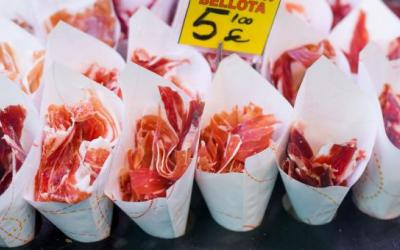In the Rostov region, they study traditions and create a future strategy for the Don viticulture and winemaking

On the eve of the start of grape harvesting, an event was held in the Starozolotovsky farm of the Konstantinovsky district, during which scientists , historians, agricultural producers and authorities discussed the past, present and future of the Don viticulture and winemaking.
Recall that two months ago in Novocherkassk, the popular science expedition "Golden Hills: Revival of the autochthons of the Don" started. it was organized by the Russian Geographical Society with the support of the government of the Rostov Region and the Wildlife of the Steppe Association. It included scientists, winemakers, local historians, and journalists. Researchers will collect information about native (autochthonous) grape varieties.
“Don viticulture and winemaking has ancient traditions, some of which have survived to this day,” said Viktor Goncharov, First Deputy Governor of the Rostov Region. - The high quality of Don wines is due to soil and climatic conditions, the existing range of plantations and winemaking technology. The method of growing covered viticulture, associated with sharp changes in daytime and evening temperatures, makes the Don wines unique and special. The purpose of the expedition is to find forgotten grape varieties and wine growing technologies in order to revive the original Don traditions, and build future plans for the industry on their basis.”
Members of the expedition presented to the participants of the meeting one of their finds - a grapevine, which was planted by the Cossacks more than 100 years ago during the formation of the so-called vineyards. Such finds are the result of a survey of local residents, a study of archives, and studies of the terrain.
As the members of the expedition assure, during the two years of their work, all varieties found will be identified, described and studied, and the best ones will be recommended for industrial production.
Historical research will also become the basis for the currently emerging strategy for the development of viticulture and winemaking on the Don, which scientists, producers and authorities gathered in Starozolotovsky to discuss.
Viktor Goncharova stressed that traditions are already being revived in the Rostov region. So, last year almost 47 hectares of young vineyards were planted, most of which are autochthonous grape varieties - Krasnostop Zolotovsky.
“At the moment, there are 1.6 thousand hectares of vineyards in the Don region. The laying of new plantings this year will be carried out on an area of 50 hectares, also in predominantly autochthonous grape varieties, - said the first deputy governor of the region - According to the results of last year, the gross grape harvest in the whole region amounted to about 10 thousand tons, almost twice as high as 2021. Harvest of the current cropstarts in August. This year, more than 61 million rubles have been allocated from the federal and regional budgets to stimulate the development of viticulture in the Rostov region. Of these, almost 6 million are the funds of the regional budget for care work in the vineyards of autochthonous varieties at a fruiting age. This year, 20 units of equipment for viticulture have been subsidized.”
It was also noted that the volume of production of wine materials for the first half of 2023 increased by 27% compared to the same period last year to 518.6 thousand decalitres (dal). The production of still wines mainly increased to 108 thousand deciliters, which is 26% more than in the first half of 2022. Basically, these indicators were achieved due to the increase in production volumes of Tsimlyansk Wines OJSC (by 57%), as well as peasant farms, which doubled their production volume compared to the same period.
“Don wines are now widely represented in Moscow, St. Petersburg and other Russian cities,” said Vladislav Sinev, President of the Agroconsulting group of companies. - We were convinced of this when we were at the international economic forum. People are actively interested in high-quality domestic brands. The popularity of Don wines is also brought by agro-tourism, which has been actively developed in recent years. We can say that our winemaking is gaining momentum, reviving the glory of the Don autochthons.”
At the end of the meeting, its participants discussed in detail the prospects for the development of the viticulture and wine industry, in particular, the draft strategy for the development of viticulture and winemaking in the Rostov region for the period up to 2030.
It was noted that one of the target indicators of the program document is to increase the share of indigenous grape varieties from 28% to 50%. In general, by 2030 it is planned that the area of vine plantations will double and reach at least 3,000 hectares. The production of wine products will also double.
The main objectives of the strategy are: stimulating the development of viticulture and winemaking, increasing the competitiveness of the Don viticulture and winemaking products through the consolidation of science and education, staffing the viticulture and winemaking industry.
Read together with it:
- A fire at the Merci Agro Sakhalin pig farm killed 1,500 pigs, but pork production will not be affected.Deputy Minister of Agriculture and Trade of the region Inna Pavlenko noted that other pig farms will help compensate for the loss. Merci Agro Sakhalin plans to restore its capacity and livestock, which will help avoid a pork shortage on the local market. The restoration will be funded by insurance payments, and veterinarians have already analyzed the condition of the remaining animals and determin...
- An HSE expert reported on the "evolution of inequality" in access to healthcare.An HSE researcher analyzed Russians' access to healthcare over a ten-year period. In 2021, the influence of financial factors became noticeable for the first time: low income reduces the likelihood of visiting a DOCTOR.Over the ten years from 2011 to 2021, the number of Russians requiring medical care but not receiving it remained virtually unchanged, according to a study by Lyudmila Zasimova, hea...
- Колумбия: При экспорте скота сертификация и прослеживаемость больше не являются необязательнымиВысококачественное животноводство, особенно при экспорте, требует сертификации и прослеживаемости. Это необходимые условия для выхода и конкуренции на многих международных рынках, а также на некоторых всё более требовательных внутренних рынках. Колумбийское животноводство не является исключением из этих правил, и, хотя предстоит ещё многое сделать, всё большее число ферм и компаний внедряют эти ме...
- Pharmaceutical companies see a threat to EU security due to bacteria in UkraineAntibiotic-resistant superbugs have been detected in Ukrainian soldiers since the beginning of the conflict, and now they pose a threat to Europe, according to a foundation developing antibiotics.The Ukrainian conflict threatens Europe with antibiotic-resistant "superbugs," said Henry Skinner, CEO of the AMR Action Fund, which specializes in investing in antimicrobials. His article was published o...
- Reuters узнал, что ЛУКОЙЛ после санкций обратился с просьбой к СШАСША ввели санкции против компании и отвели месяц на сворачивание операций — срок истекает 21 ноября. ЛУКОЙЛ добивается продления, поскольку ему нужно больше времени для изучения предложений по поводу активов, сообщает REUTERS ЛУКОЙЛ попросил Минфин США о продлении крайнего срока для завершения операций после введения санкций, сообщает Reuters со ссылкой на три источника. Вашингтон ввел санкции про...
- В Амурскую область поступило свыше 6 тысяч тонн мяса птицы из КитаяС 3 июня по 6 ноября инспекторы проверили 290 партий мяса, все из которых были сопровождены ветеринарными сертификатами, подтверждающими их качество и безопасность. Лабораторные исследования, проведенные под контролем Россельхознадзора, не выявили нарушений, и груз был допущен на территорию России.
- Wild boar meat: a sustainable solution for pest controlThis problem isn't unique to our region or country. As veterinarian and specialist Ignacio Zeledon explained, "Where there's water, there are pigs." And the truth is, its spread is noticeable worldwide and represents one of the world's most complex environmental and economic challenges. The wild boar (Sus scrofa) is an invasive alien species, listed among the 1......




























































